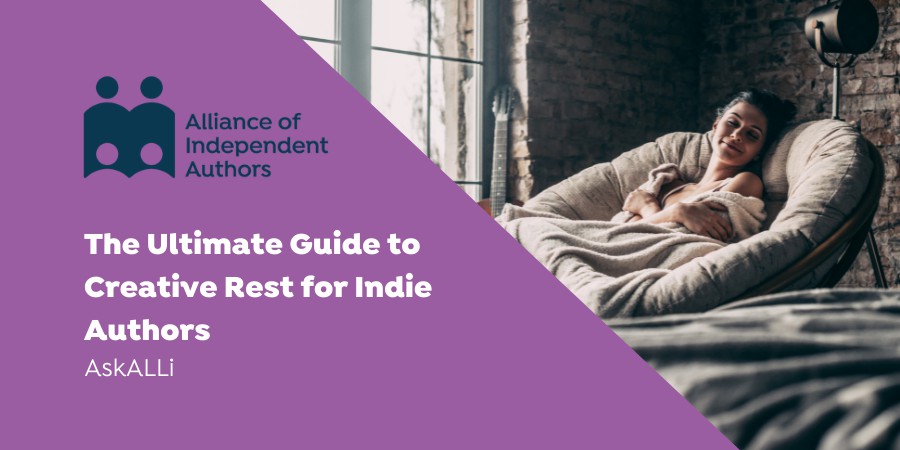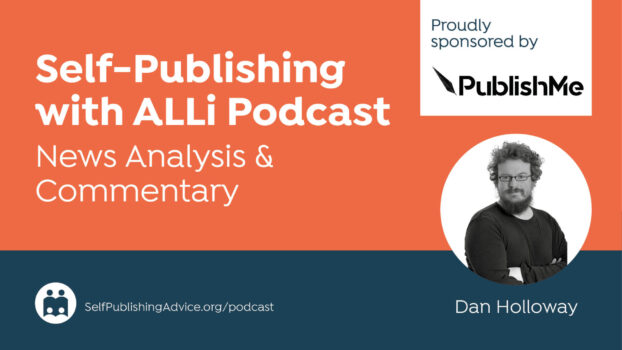Ask a dozen people what rest looks like, and you'll get a dozen different answers. Indie authors by nature tend to be workaholics. We have to wear so many hats, and so many roles to play, it's often difficult to remember one of those hats should be self-care. Today, the Alliance of Independent Authors AskALLi team is diving into what creative rest for indie authors should look like.
With the rise in digital technology, there's been an increasing pressure to just “write faster, work harder, burn longer”. Naturally, the result has seen an increasing number of “burnouts” in the indie community. Much as we might like to just work all day—because let's face it, our jobs are play and who doesn't want to play all day—our human bodies have limits.
In consumer culture, “time is money” and, by implication, must be filled with activity. This attitude, together with the ubiquity of communication gadgets, means that more and more people are always “on”. So much so that apparently we now need rest gurus to teach us how to intentionally rest.
Those who operate from an intellectual understanding of life tend to view sleep as downtime, disconnected from the business of real living, what Edgar Allan Poe called ”little slices of death”. But much recent research is confirming the importance of sleep to our creative capabilities, in particular REM (rapid eye movement) sleep, the period while we are in deep dreaming.
Creative Rest for Indie Authors: Sleep
Sleep is such an integral component of our lives that we may not question it but for creatives, sleep is a magic zone, full of mystery. Science tells us that quality sleep bestows all sorts of physical and psychological benefits, essential to wellness, from increased energy to better cognitive responses. A growing body of research is showing how key good sleep and rest are to our creative capabilities.
The conclusion is simple. If you want to make great things, begin getting more REM sleep. How? Essentially, by sleeping longer.
REM sleep tends to begin approximately 90 minutes into the sleep cycle, after which we typically experience a period every 60-90 minutes. The first REM period is only about five minutes long — but the duration increases as the sleep goes on, with the fourth or fifth period lasting up to an hour. So if you sleep for more than seven hours, you get a great deal more REM sleep than if you only sleep six hours or fewer.
REM releases acetylcholine, a chemical that induces the hippocampus and neocortex to enter a flexible state and connector neurons to form more easily. This allows our neocortex—the part of the brain responsible for our highest cognitive functions—to search for and establish connections between seemingly unrelated things.
This brain activity is what underlies waking up with the answer to a problem you’ve been working on.
Commit to sleep. Understand its importance to high creative functioning and honour that. Your bedroom may already be the container for your sleep and sexual life. Make it also part of your creative life.
Make your bedroom a place of comfort and delight, with perfect lighting, temperature, sound, scents, mattress, pillows, cushions and throws. Have capturing tools—a notebook and pen—close by. When you waken at 3am with the perfect sentence, character flow, problem solver or story resolution, you want to be able to capture it. Don’t use your phone for this, if you’re going to start scrolling late at night or early morning.
Practice a bedtime ritual that is not just calming—taking a bath for example—but that consciously connects your sleep and your creative work. Avoid electronics and looking at screens, especially scrolling other people’s ideas and thoughts, for two hours before you sleep. Switch off and chill.
At bedtime, take a few moments to return to your own work. Put a note with the next scene, idea, or creative challenge you’re facing in your book or your business under your pillow, knowing you’ll wake with the solution.

Photo by Paul Hanaoka on Unsplash
Creative Rest for Indie Authors: Naps
Once or twice a day (more often in childhood and old age) we shift out of our awake, conscious, thinking (con) mind into our asleep, subconscious and unconscious (creative) mind. You are tired. You rest and when you waken, it’s as if you’ve been dipped in creative energy — ready to go again.
Many high-achievers from all walks of life swear by the value of naps: the emperor Napoleon, the inventor Thomas Edison, the activist Eleanor Roosevelt. And countless artists and writers have left accounts of their adventures in sleep and other forms of rest, as sources of creative flow.
In The Gathering Storm, the first in Winston Churchill’s monumental six-volume account of World War II from his vantage point as British prime minister, the literature Nobel-laureate and arch-politician put his ability to get things done down to his napping habit.
Nature has not intended [humankind to work from eight in the morning until midnight without that refreshment of blessed oblivion which, even if it only lasts twenty minutes, is sufficient to renew all the vital forces… Don’t think you will be doing less work because you sleep during the day. That’s a foolish notion held by people who have no imaginations. You will be able to accomplish more. You get two days in one — well, at least one and a half.
Naps enhance your creativity by boosting all your brain functions, including accuracy, concentration, critical thinking skills, focus, mood and physical performance, while lowering stress and fostering the relaxation response that's essential to being in creative, receptive mode.
Creative Rest for Indie Authors: Micro Sleeps
In his book 50 Secrets of Magic Craftsmanship: Salvador Dali described his micro-napping technique. He falls asleep in a chair, with a key in his hand and beneath his hand, on the floor, an upside-down tip plate. As he falls asleep, his hand releases the key which clangs onto the plate and the painter awakes with a start, noting whatever image or idea was in his mind, on the moment of waking.
The moment the key drops from your fingers, you may be sure that the noise of its fall on the upside-down plate will awaken you, and you may be equally sure that this fugitive moment when you had barely lost consciousness and during which you cannot be assured of having really slept is totally sufficient, inasmuch as not a second more is needed for your physical and psychic being to be revivified, by just the necessary amount of repose.
This sleep stage is called hypnagogia, an in-between state where you are between consciousness and dreaming, and a rich source of imagery and creative energy, enabling us to see things differently and make unusual connections.
- Philosopher John Dewey, who said people were most creative when they are “relaxed to the point of reverie.”
- Poet Samuel Taylor Coleridge, whose “Kubla Khan” is a half-dreamed, opium-fuelled, reverie
- Composers Wagner, Motzart and Beethoven, who captured ideas that surfaced while napping in their carriages
- Inventor Thomas Edison used a technique similar to Dali's
Micro-napping also side-steps the groggy feelings that you can be left with after napping for longer than 20 minutes.
ALLi Director Orna Ross's own sleep experiments have found that a full 90 minute cycle also circumvents grogginess, and makes the second part of the day as creatively productive as the first.
In short, get more sleep and get better sleep, at night-time and during the day.
Other Creative Breaks
Taking a break improves productivity. Many studies indicate that taking frequent breaks throughout the day is beneficial to our performance – but they need to be certain kind of breaks. For writers, a social media scroll or internet surf doesn’t count as restorative rest. It's too much like the same activity, producing similar sort of brain waves and only making you more tired.
You own't like hearing this, but for a break to actually have a regenerative effect, you must completely disconnect from whatever it is that you are doing.
The best way for writers is exercise. Get up and out of your office chair and take a stroll through the great outdoors (bonus points for meandering through nature). But, and this bit is important, don't take your phone, or any technology except a notebook and pencil to take a quick capturing note, should a brainwave present itself.
A quick “disco nap” is also restorative. That's a nap taken before a night out.

Photo by John Arano on Unsplash
Different Types of Rest
In our hyper-stimulated, always on world, many of us are suffering from different flavors of tiredness.
Sometimes our bodies need rest, other times it's our minds, or perhaps our creative well needs refilling.
In an article for Resurgence Magazine, writer and rest activist Matt Carmichael identified seven forms of tiredness afflicting us — individually and as a society. The solutions Carmichael offers are not always about sleep, but also include spiritual and creative refreshment.
- Sleepiness, physically tired (Solution: sleep)
- Fatigue, activity tired (Solution: downtime)
- Ennui, stasis tired (Solution: play, fun)
- Satiation, consumption tired (Solution: sacrifice)
- Despair, expectation tired (Solution: compassion)
- Disillusion, faith tired (Solution: deep learning)
- Stress, frustration tired (Solution: meditation)
To some, exercising be it swimming, running, martial arts, climbing or something else, can seem like the opposite of restful activity. But, let us not forget exercise releases endorphins and more endorphins mean more happy hormones.
The relationship between exercise and sleep has been extensively investigated and found to have what experts call a “bidirectional relationship: optimizing your exercise routine can potentially help you sleep better and getting an adequate amount of sleep may promote healthier physical activity levels during the day.
Interestingly, in a study conducted by Durham University, including 18,000 people across 135 countries, “respondents who did more exercise also believed that they got more rest.”
So although exertion uses energy, it also promotes restoration. The study continued to shed light on activities alone versus together.
It probably won't come as a surprise to a group of writers that:
“…the top five of the most popular forms of resting are things people often do on their own. One researcher worked out that on average we spend about 29 percent of our waking time alone.”
Finally, it is no surprise at all that in the same Rest Test Global survey, the number one way people like to rest while awake is:
“1) Reading: The unconscious ability to speed up and slow down the pace of our reading, to linger over the good bits or skip over the dull passages helps to make reading so absorbing and relaxing, according to Claudia Hammond. And, like music, it’s all about reading what you enjoy most.”
So good news for us indie authors then!
Creative Rest: ALLi Member Experiences
Lisa M. White
“What I do for rest depends on what I’m doing for work. I tend to cycle through things. So I’ll catch up on a TV series or reading after I’ve completed a block of work such as a draft, editing, or I’ve published something. Usually what I do for resting and recharging is the opposite of what I’ve been doing a lot of. So if I’ve been sitting and writing all day, I try to balance it with exercise and catching up with a friend or family. I also find reading in a different genre than I’m writing or researching restful too.”
R.A. Harrison
“Writing is my rest! I'm a piano teacher by trade, finally coming out of online teaching and seeing my pupils face-to-face for the first time in nearly fifteen months. I went back to writing as an escape during lockdown (it had been squeezed out by ‘life' many years ago) and now I'm completely hooked … and resenting the days when there's just too much admin to bury myself back in my imaginary world.”
SJ Banham
“My creative downtimes/research times are mostly the following: exercise daily, usually while listening to podcasts on writing/business or audiobooks. I create craft things too, I'm currently finishing a life long quilt project that's intended to be an heirloom (it's a bit on the quirky side so don't expect perfect quilt designs here!). I also research while watching movies so I can see how the actors deal with certain situations and that, in turn, helps me with my own. Also, I meditate which helps my mental health. All of these things are done daily (or weekly, with the quilt). My own writing is paramount in creative time usage, but I make it part of my working day along with business stuff. Happy to be quoted.”
Berenice Smith
“My many years in graphic design mean I’m all about precision and alignment, this font or that weight etc and it’s really hard to switch off! So I paint and sketch, often with ink and watercolours as there is less control. I also go to the beach and walk my dog and get a little lost in the irregularity of nature. Meditation also helps to slow down my mind.”
“I go out and meet friends as writing can be a lonely life. I also walk my dogs every day and get lots of creative ideas doing that. I have a large garden too. I find now I have more experience, I don’t worry if I get a minor block. It’s a sign to stop and let the subconscious sort it out. When I wrote non-fiction and journalism for decades, I just used to power through it but that doesn’t always work with my fiction writing.”
Chrissie Parker
“I’ve learned to create office hours in a space in my house that is an actual office that I can close the door on.Outside of those hours I walk the canal, spend time with my family or in my garden. Do a hobby or something that takes my mind off work. After 14months of serious illness this reevaluation of how I now work came the hard way!”
Walter Boomsma
“I'd agree there are different types of rest–one thing that makes this question difficult to answer. Lots of other “R Words” come to mind such as recharge, relax, recover… I love alliteration. Rest usually implies a break or change. So when I read “creative rest” I hear a break from creativity–which might be different than a break from writing. I don't know how to take a break from creativity because I don't feel like I have (or want) control over when creativity strikes. Writing centers me but I sometimes find it necessary to take a break from it to get the wheels turning. One additional thought includes an appeal for departure from compartmentalization. One man's work is another man's rest in much the same way as one man's trash is another man's treasure.”
Holly Lyne
“When I need rest from creativity then I find reading and watching TV/films really does the trick. I need to constantly consume stories, that never stops, and doesn't drain me at all in the way that outputting can. If I need a break from writing but want to keep my creativity ticking over, then I do some colouring, or drawing, create pretty spreads in my bullet journal, or play music or sing. I do find that I benefit from this more than stopping creativity altogether, as inertia can be difficult to break.”
Roz Morris
“Riding my horse! He demands 100% attention. No daydreaming – he'll know I'm not looking after him with all my body and soul. He knows all my emotions too – if I'm frustrated about a creative or work problem, he reads that and thinks there's danger or he's in trouble. So riding my horse demands a complete wipe of all other thoughts. Just be there in the moment, looking after him, enjoying him.”
“I do a lot of different things – yoga, for one, which takes your mind completely away from what you were otherwise doing. I love standing on my head, which at age 79 is still possible but a bit unusual. I also love singing with my choir, which has just re-started in person by singing in the church yard of the church we had planned to rehearse in.”
Julie Cordiner
“Walks on the beach, currently binge listening to the fab Rebel Author podcast! Knitting, which is curiously good for giving me ideas for writing. I don't watch much TV but will romp through a series like Unforgotten if I've heard it's good. Always reading… My nonfiction author name is Julie Cordiner and historical fiction pen name is Juliette Lawson.”
Kristina Adams
“This is a hard question for me as someone with fibromyalgia and chronic fatigue syndrome. I have to monitor my mental and physical health in order to work out if/when I need to rest. Last week, I had to take Thursday off because I was in a lot of physical pain and the brain fog was STRONG. I had lots of work to do, but my brain and body kept slamming the brakes on. I knew if I didn't listen I'd end up worse off and able to do even less.
I'm definitely not one for going outdoors to take a break. I'm trying to grow some vegetables as something different, but I'm about as un-outdoorsy as you can get. I'm much more of a ‘resting on the sofa and getting puppy cuddles' kind of person. Most of my downtime is spent watching skincare videos or playing with the dog.
I try to meditate daily, although I've gotten lax lately. It 100% makes a difference when I meditate, though. It's the best thing for calming my racing mind. The days when I meditate first thing are always the most productive.”
Susan Wilkins
“At the end of a long writing day I like to cook. I wish I could say I’m good at it, but really I’m not. What I always try to do though, is use fresh ingredients and cook from scratch. This can be taxing sometimes. However, going from a keyboard to cutting up an onion and making a simple tomato sauce is therapeutic for me. Unfortunately then we often end up sitting in front of the telly to eat, while watching the news. This tends to ruin the effect.”
“Really hard exercise is the only way I can get my mind to rest, which is what I find I need creatively. I love running long distances until I'm in an almost trance like state (it's beyond me but one of the world's longest races, at 3100 miles, is called the “self-transcendence race” for this reason). But the thing that really does it is lifting heavy weights, in particular powerlifting. The level of concentration required to stay safe focuses the mind absolutely and it simply can't wander, and that is the most wonderfully refreshing feeling, and the only way I know to really escape my thoughts so I can come back to them renewed.”
Aureal Williams
“I rest with the Moon — the Void of Course Moon times, and the Dark of the Moon in both the Collective and Personal Lunar cycles. This rest is prompted by an internal pull of gravity; by body tells me it is time to rest, and I listen. Sometimes this means stillness; other times it means being quiet and reflective, focusing on inner work. I also rest in alignment with my with own circadian rhythm, which is based on the time of my birth. This rhythm, too, is a felt experience that directs my choices to rest.”




